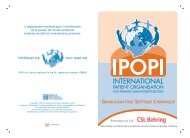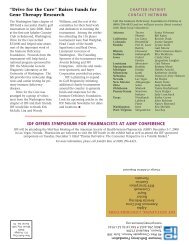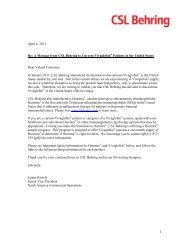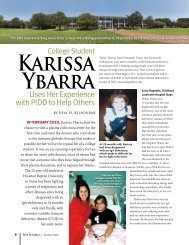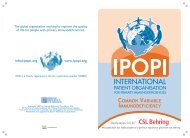IDF Patient & Family Handbook for Primary Immunodeficiency ... - IDFA
IDF Patient & Family Handbook for Primary Immunodeficiency ... - IDFA
IDF Patient & Family Handbook for Primary Immunodeficiency ... - IDFA
You also want an ePaper? Increase the reach of your titles
YUMPU automatically turns print PDFs into web optimized ePapers that Google loves.
102 Specific Medical Therapy<br />
Gene Therapy<br />
Most of the primary immunodeficiency diseases<br />
are caused by “spelling” defects (mutations) in<br />
specific genes. It has long been the dream of<br />
physicians that one day it would be possible to<br />
cure these diseases by fixing the mutation that<br />
causes the disease and restore the patient to<br />
normal health. As a result of the human genome<br />
project and similar ef<strong>for</strong>ts to map all of the<br />
genes present in human beings, we now know<br />
the identities of the specific genes involved in<br />
many diseases, including the majority of primary<br />
immunodeficiency disorders, with more genes<br />
being identified nearly every week. Finally, we have<br />
reached the stage where that long held dream is<br />
becoming reality with the cure of a few patients<br />
with primary immunodeficiency diseases leading<br />
the way, just as these diseases were the first<br />
disorders cured by bone marrow transplantation<br />
when it was introduced in the late 1960s.<br />
Not every genetic disorder will eventually be<br />
correctable by gene therapy and this is also<br />
probably true <strong>for</strong> some primary immunodeficiencies,<br />
but primary immunodeficiency diseases as a<br />
general rule are better suited <strong>for</strong> this therapy<br />
than almost any other class of genetic disease.<br />
Transplantation of bone marrow taken from a<br />
normal donor has been successful in curing<br />
many of these disorders, so it should also be<br />
possible to take the patient’s own bone marrow<br />
and correct the genetic defect in those cells by<br />
adding a normal copy of the gene that is causing<br />
the disease. We should always have the patient’s<br />
own bone marrow so the absence of a suitable<br />
matched marrow donor will not be a problem<br />
<strong>for</strong> the gene therapy approach. Similarly, GvHD<br />
should not be a problem when the patient’s own<br />
HSC are used <strong>for</strong> the transplant. Also, since bone<br />
marrow cells are readily removed from the body<br />
and worked on in the laboratory, it is much easier<br />
to deliver the corrective gene to these cells in the<br />
test tube than it would be if we needed to deliver<br />
the genes to cells still remaining in the body like<br />
the liver, heart, lungs or muscles.<br />
Although it is beyond the scope of this chapter<br />
to describe the technology of gene transfer in<br />
detail, in the first cases successfully treated by<br />
gene therapy, the corrective genes were packaged<br />
inside a modified virus (called a vector). These<br />
modified viruses were then used to deliver the<br />
disease fighting gene to the patient’s lymphocytes<br />
or HSC in laboratory culture. After two to four<br />
days, to allow the viruses to insert the genes,<br />
these cultured cells were washed and then given<br />
to the patients just as if they were receiving a<br />
blood or bone marrow transfusion. The particular<br />
viruses used were from a class of viruses<br />
(retroviruses) that normally insert their own genetic<br />
material directly into the chromosomes of the cells<br />
that they infect. The viral genetic material becomes<br />
part of the genetic inheritance of the cells that<br />
they infect including the characteristic that the viral<br />
genes then get transmitted to the cell’s daughters<br />
when cell division occurs. For use in gene therapy,<br />
the viruses own genes are discarded and replaced<br />
with the genes that we want delivered, but by<br />
using the machinery of the virus—now the disease<br />
correcting gene becomes part of the inheritance<br />
of the vector treated cells and this results in cure<br />
that is transmissible to all of the daughter cells that<br />
normally develop from the originally treated cell.<br />
As we know, relatively few HSC can give rise to all<br />
of the blood and immune system cells in the body<br />
<strong>for</strong> life and because these stem cells divide and<br />
reproduce, the genetic correction added to the<br />
stem cells will spread widely to many different blood<br />
and immune system cells and also last <strong>for</strong> life.<br />
The first clinical trial of gene therapy was in<br />
1990 and treated a four-year-old girl with ADA<br />
deficiency. In this first use of gene transfer the<br />
ADA gene was inserted into T-lymphocytes grown<br />
from the girl’s blood using a combination of T-cell<br />
growth factor and T-cell receptor stimulation.<br />
After the cells were treated with the ADA vector<br />
and expanded in culture by several dozen fold<br />
they were infused into her vein periodically <strong>for</strong><br />
a total of twelve infusions over two years. Now,<br />
this girl is clinically well and still has about 25% of<br />
her circulating T-cells carrying the corrective ADA<br />
gene. The design of this first trial did not attempt<br />
to correct the defective HSC and there<strong>for</strong>e gene<br />
correction has been limited to the T-cells.








